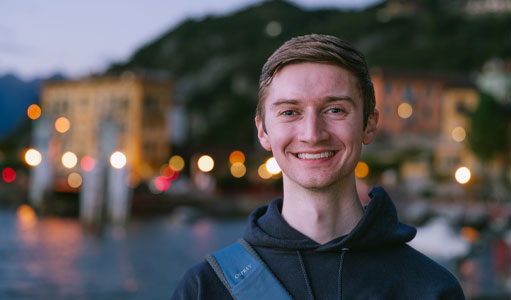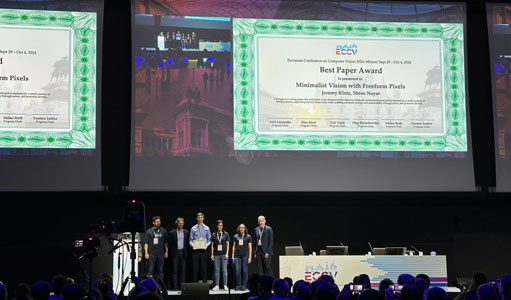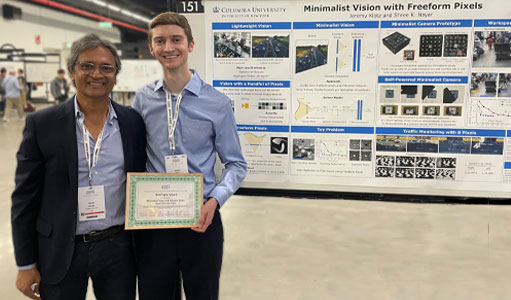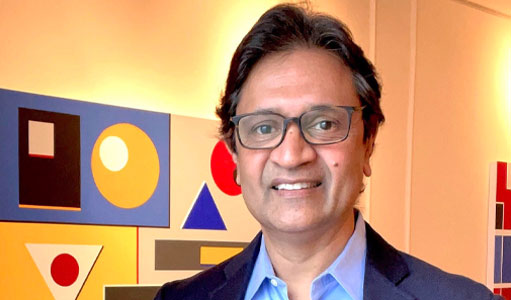How Your Smartphone’s Camera Got So Good
Professor Shree Nayar’s lab revolutionized digital photography with a new kind of imaging now used in more than a billion smartphones.
Professor Shree Nayar’s lab revolutionized digital photography with a new kind of imaging now used in more than a billion smartphones.
In a world fixated on ever-higher resolutions and increasingly detailed images, a revolutionary new camera takes a daring step in the opposite direction. The Minimalist Camera is an innovation designed to prioritize efficiency and privacy over unnecessary detail. By capturing only the minimal data needed for a specific task, this groundbreaking technology challenges conventional thinking about imaging—and redefines what cameras don’t need to do.

Developed by Jeremy Klotz, a third-year PhD student in the CAVE Lab, in collaboration with Professor Shree Nayar, the minimalist camera forgoes traditional images. Instead, it relies on a handful of custom-shaped “freeform” pixels, carefully tailored to the task at hand. The result? A device that preserves privacy by avoiding the capture of identifiable details while consuming so little power that it’s entirely self-sustaining. Whether monitoring traffic flow or analyzing crowd movements, this camera captures only the essential data—empowering practical applications without compromising individual privacy.

The innovation has not gone unnoticed, earning a Best Paper Award at the European Conference on Computer Vision (ECCV 2024). More than just an accolade, the minimalist camera signals a paradigm shift in how cameras can function in our increasingly interconnected world.
We caught up with Klotz to explore the story behind the minimalist camera, the ups and downs of PhD life, and what it means to push the boundaries of imaging technology in the name of privacy and efficiency.
Q: How did you develop the idea for the minimalist camera?
When I started my PhD, my advisor and I began brainstorming research directions. After discussing different ideas, we landed on the high-level concept of creating a camera that captures the least information necessary to perform a vision task. In contrast to a traditional camera that uses millions of tiny square pixels, our idea was to let each pixel take on an arbitrary shape (which we call a freeform pixel). Once we evaluated this idea in simulation, we found that freeform pixels can solve vision tasks with significantly fewer pixels than traditional cameras.
I worked with my advisor on every aspect of the project, from refining the high-level idea to building a prototype camera. This involved careful thinking about how to design freeform pixels, simulating them in software, and then building a camera that uses a very small number of freeform pixels to solve real-world vision tasks. This project took about one and a half years from start to finish.

Q: Can you describe your research focus and what motivates your work?
My research is in computational imaging, where we design new cameras using novel hardware and software. This area is particularly exciting since it merges research in computer vision (typically all software) with imaging hardware. In particular, I love building prototypes to demonstrate our research ideas. Working with hardware is definitely challenging, but seeing a prototype work at the end of the day makes it even more rewarding.
I’m interested in asking questions like, “What are the fewest measurements needed to solve a vision task?” and “How can we build a camera that captures the fewest measurements?” These questions are particularly relevant right now. Most cameras produce exceptionally high-quality images, but this comes at a cost: high-resolution images often reveal too much information about the world, and the cameras consume so much power that they can only be deployed on buildings (with a tether for power) or with a battery that needs to be recharged.
Q: Why did you decide to pursue a PhD?
Before coming to Columbia, I studied electrical and computer engineering at Carnegie Mellon. While I was an undergrad, I was introduced to research in computational imaging. I didn’t plan to pursue a PhD at the time, but after this foray into research, I found that I really enjoyed the open-ended problems and decided to pursue a PhD.
My undergraduate research was the most important experience that prepared me for my PhD. Although it’s hard to completely understand what a PhD entails until you start, my undergrad research introduced me to how it feels to do research full-time and what it’s like to work with a professor rather than for a professor.
Now as a PhD student, my work’s direction is completely up to me. If I believe that an idea is worth pursuing, then I can commit all of my time to working on it. This freedom is incredible, and it allows me to choose the most interesting problems to work on.
Q: What standout moments or experiences have shaped your journey at Columbia so far?
I’ve really enjoyed going to conferences—presenting research and meeting others in the field is a blast. I’ve also enjoyed attending department seminars on research outside my area. It’s helped me to ask thoughtful questions about work in other fields.
With my research, we’ve had quite a few ideas that simply don’t work out. My strategy is to try to determine if a new idea is viable as early as possible, and quickly pivot if it isn’t.
Q: What is your advice to students on how to navigate their time at Columbia?
If you want to do research, keep an open mind to explore areas you may not be familiar with. A lot of research can appear intimidating at first, but the students and faculty working in the area are extremely passionate and excited to chat if you ask.
Computer scientist honored for his pioneering research in imaging.
Computer Scientist honored for his pioneering research in imaging.
Computer scientist honored for his pioneering research in imaging and vision.
Computer scientist honored for his pioneering research in imaging and vision.
Professor Shree Nayar created the course, which offers an interdisciplinary approach to computer vision. The specialization is designed for learners to acquire the foundational mathematical and physical underpinnings of computer vision.
Columbia Engineering announces the launch of a new MOOC Specialization — First Principles of Computer Vision, offered on Coursera, a leading provider of massive open online courses (MOOCs). The five-course specialization is designed for learners to acquire the foundational mathematical and physical underpinnings of computer vision.
Today, computer vision has emerged as the primary form of artificial intelligence in some of the newest and most exciting technological innovations including driverless cars, medical imaging, optical character recognition, virtual reality, interactive games, and more. The expanding applications of computer vision cement it as an important aspect of the often-changing world of technology and artificial intelligence. As such, this program helps satisfy the rising demand for workers that understand computer vision and its real-world applications, opening learners to the opportunity for jobs, such as computer vision hardware engineers or computer vision researchers.

Shree Nayar, T.C. Chang Professor of Computer Science and instructor for this course, describes the implications of computer vision, “The goal of computer vision is to build machines that can see. We’ve already seen very successful applications of vision such as face recognition and driverless cars. There is much more to come. In the next decade, we can expect computer vision to have a profound impact on the way we live our lives.”
First Principles of Computer Vision Specialization consists of five courses covering topics such as Camera and Imaging, Features and Boundaries, 3D Reconstruction Single Viewpoint, 3D Recognition Multiple Viewpoints, and Perception. This specialization offers an interdisciplinary approach to computer vision, giving learners a full-spectrum view of its foundations. As Nayar describes it, “While we approach vision as an engineering discipline in this program, when appropriate, we make connections with other fields such as neuroscience, psychology, art history, and even biology.”
Find out more about First Principles of Computer Vision via the following link: https://www.coursera.org/specializations/firstprinciplesofcomputervision.
Shree K. Nayar has been awarded the prestigious Funai Achievement Award from the Information Processing Society of Japan for his seminal work on computer vision and computational imaging. Nayar will receive the award at the Forum on Information Technology (FIT) to be held in Sendai, Japan, in August 2021.
Find open faculty positions here.
President Bollinger announced that Columbia University along with many other academic institutions (sixteen, including all Ivy League universities) filed an amicus brief in the U.S. District Court for the Eastern District of New York challenging the Executive Order regarding immigrants from seven designated countries and refugees. Among other things, the brief asserts that “safety and security concerns can be addressed in a manner that is consistent with the values America has always stood for, including the free flow of ideas and people across borders and the welcoming of immigrants to our universities.”
This recent action provides a moment for us to collectively reflect on our community within Columbia Engineering and the importance of our commitment to maintaining an open and welcoming community for all students, faculty, researchers and administrative staff. As a School of Engineering and Applied Science, we are fortunate to attract students and faculty from diverse backgrounds, from across the country, and from around the world. It is a great benefit to be able to gather engineers and scientists of so many different perspectives and talents – all with a commitment to learning, a focus on pushing the frontiers of knowledge and discovery, and with a passion for translating our work to impact humanity.
I am proud of our community, and wish to take this opportunity to reinforce our collective commitment to maintaining an open and collegial environment. We are fortunate to have the privilege to learn from one another, and to study, work, and live together in such a dynamic and vibrant place as Columbia.
Sincerely,
Mary C. Boyce
Dean of Engineering
Morris A. and Alma Schapiro Professor